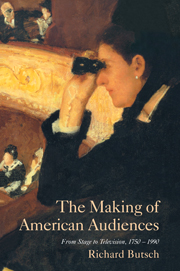Book contents
- Frontmatter
- Contents
- Acknowledgments
- Introduction: Participative Public, Passive Private?
- 1 Colonial Theater, Privileged Audiences
- 2 Drama in Early Republic Audiences
- 3 The B'Hoys in Jacksonian Theaters
- 4 Knowledge and the Decline of Audience Sovereignty
- 5 Matinee Ladies: Re-gendering Theater Audiences
- 6 Blackface, Whiteface
- 7 Variety, Liquor, and Lust
- 8 Vaudeville, Incorporated
- 9 “Legitimate” and “Illegitimate” Theater around the Turn of the Century
- 10 The Celluloid Stage: Nickelodeon Audiences
- 11 Storefronts to Theaters: Seeking the Middle Class
- 12 Voices from the Ether: Early Radio Listening
- 13 Radio Cabinets and Network Chains
- 14 Rural Radio: “We Are Seldom Lonely Anymore”
- 15 Fears and Dreams: Public Discourses about Radio
- 16 The Electronic Cyclops: Fifties Television
- 17 A TV in Every Home: Television “Effects”
- 18 Home Video: Viewer Autonomy?
- 19 Conclusion: From Effects to Resistance and Beyond
- Appendix: Availability, Affordability, Admission Price
- Notes
- Selected Bibliography
- Index
- Plate section
11 - Storefronts to Theaters: Seeking the Middle Class
Published online by Cambridge University Press: 05 June 2012
- Frontmatter
- Contents
- Acknowledgments
- Introduction: Participative Public, Passive Private?
- 1 Colonial Theater, Privileged Audiences
- 2 Drama in Early Republic Audiences
- 3 The B'Hoys in Jacksonian Theaters
- 4 Knowledge and the Decline of Audience Sovereignty
- 5 Matinee Ladies: Re-gendering Theater Audiences
- 6 Blackface, Whiteface
- 7 Variety, Liquor, and Lust
- 8 Vaudeville, Incorporated
- 9 “Legitimate” and “Illegitimate” Theater around the Turn of the Century
- 10 The Celluloid Stage: Nickelodeon Audiences
- 11 Storefronts to Theaters: Seeking the Middle Class
- 12 Voices from the Ether: Early Radio Listening
- 13 Radio Cabinets and Network Chains
- 14 Rural Radio: “We Are Seldom Lonely Anymore”
- 15 Fears and Dreams: Public Discourses about Radio
- 16 The Electronic Cyclops: Fifties Television
- 17 A TV in Every Home: Television “Effects”
- 18 Home Video: Viewer Autonomy?
- 19 Conclusion: From Effects to Resistance and Beyond
- Appendix: Availability, Affordability, Admission Price
- Notes
- Selected Bibliography
- Index
- Plate section
Summary
Almost from its beginning the movie industry had sought a middle-class audience. Producers hoped to attract the “better classes” by publicizing their efforts at regulation and their responsiveness to reformers' criticisms. Some studios produced films of literary and dramatic classics and avoided the histrionic acting associated with cheap melodrama and lower-class audiences.
Exhibitors in smaller towns were among the earliest to seek a middle-class clientele, since they had to cater to a broader market. A Lexington, Kentucky nickelodeon advertised “polite, fashionable moving pictures … a nice place to spend a half-hour: With the children! With your wife! With your girl!” Another employed uniformed doormen and ushers to ensure order and encourage women and children to attend. A show in Milwaukee gave away a bottle of perfume to women attending matinees; they offered baby sitting as well.
But the major change and the major investment was moving toward regular theaters. There were many more storefront movie shows, but theaters quickly became an important part of the business and increased the visible middle-class clientele. The trade press from 1907 to 1913 urged exhibitors to attract a middle-class audience by refurbishing storefronts into “handsomely decorated and well-equipped little theatres.” Nickelodeon owners who made good profits – not all did – soon began looking for ways to invest their profits and heeded such advice.
- Type
- Chapter
- Information
- The Making of American AudiencesFrom Stage to Television, 1750–1990, pp. 158 - 172Publisher: Cambridge University PressPrint publication year: 2000
- 1
- Cited by



